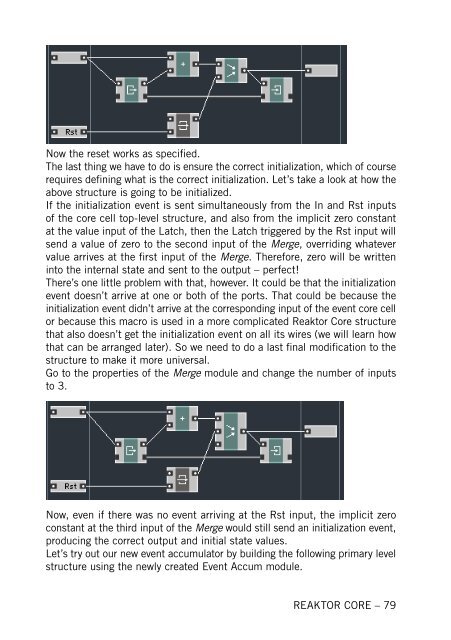1. First steps in Reaktor Core - Native Instruments
1. First steps in Reaktor Core - Native Instruments
1. First steps in Reaktor Core - Native Instruments
You also want an ePaper? Increase the reach of your titles
YUMPU automatically turns print PDFs into web optimized ePapers that Google loves.
Now the reset works as specified.<br />
The last th<strong>in</strong>g we have to do is ensure the correct <strong>in</strong>itialization, which of course<br />
requires def<strong>in</strong><strong>in</strong>g what is the correct <strong>in</strong>itialization. Let’s take a look at how the<br />
above structure is go<strong>in</strong>g to be <strong>in</strong>itialized.<br />
If the <strong>in</strong>itialization event is sent simultaneously from the In and Rst <strong>in</strong>puts<br />
of the core cell top-level structure, and also from the implicit zero constant<br />
at the value <strong>in</strong>put of the Latch, then the Latch triggered by the Rst <strong>in</strong>put will<br />
send a value of zero to the second <strong>in</strong>put of the Merge, overrid<strong>in</strong>g whatever<br />
value arrives at the first <strong>in</strong>put of the Merge. Therefore, zero will be written<br />
<strong>in</strong>to the <strong>in</strong>ternal state and sent to the output – perfect!<br />
There’s one little problem with that, however. It could be that the <strong>in</strong>itialization<br />
event doesn’t arrive at one or both of the ports. That could be because the<br />
<strong>in</strong>itialization event didn’t arrive at the correspond<strong>in</strong>g <strong>in</strong>put of the event core cell<br />
or because this macro is used <strong>in</strong> a more complicated <strong>Reaktor</strong> <strong>Core</strong> structure<br />
that also doesn’t get the <strong>in</strong>itialization event on all its wires (we will learn how<br />
that can be arranged later). So we need to do a last f<strong>in</strong>al modification to the<br />
structure to make it more universal.<br />
Go to the properties of the Merge module and change the number of <strong>in</strong>puts<br />
to 3.<br />
Now, even if there was no event arriv<strong>in</strong>g at the Rst <strong>in</strong>put, the implicit zero<br />
constant at the third <strong>in</strong>put of the Merge would still send an <strong>in</strong>itialization event,<br />
produc<strong>in</strong>g the correct output and <strong>in</strong>itial state values.<br />
Let’s try out our new event accumulator by build<strong>in</strong>g the follow<strong>in</strong>g primary level<br />
structure us<strong>in</strong>g the newly created Event Accum module.<br />
REAKTOR CORE – 79










